人教版(2019)选择性必修 第二册Unit 5 First Aid Discover useful structures 课件(共41张PPT)
文档属性
| 名称 | 人教版(2019)选择性必修 第二册Unit 5 First Aid Discover useful structures 课件(共41张PPT) |  | |
| 格式 | pptx | ||
| 文件大小 | 129.6KB | ||
| 资源类型 | 教案 | ||
| 版本资源 | 人教版(2019) | ||
| 科目 | 英语 | ||
| 更新时间 | 2023-12-06 20:16:34 | ||
图片预览


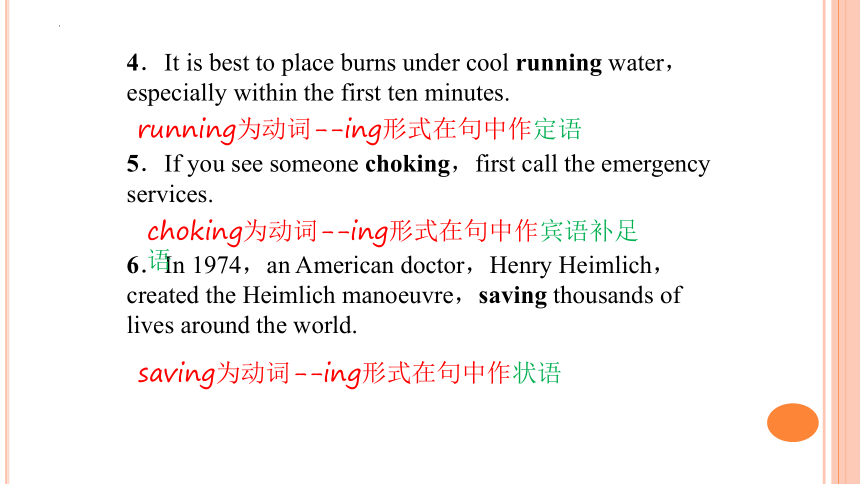
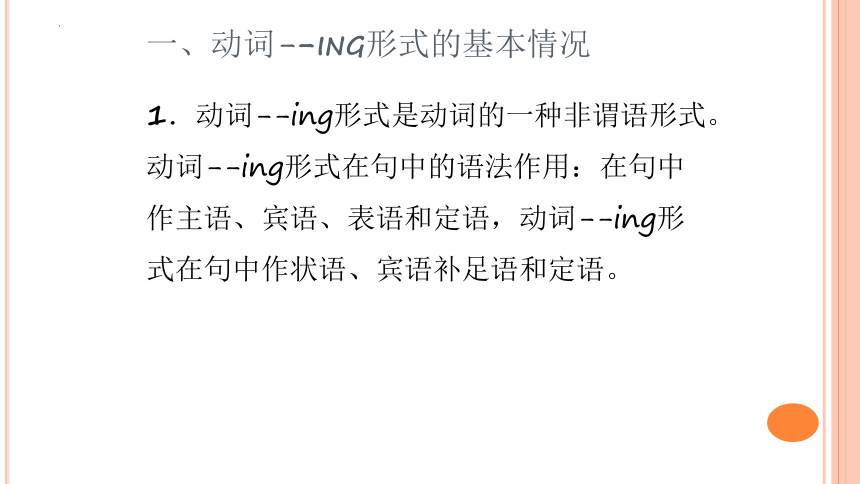
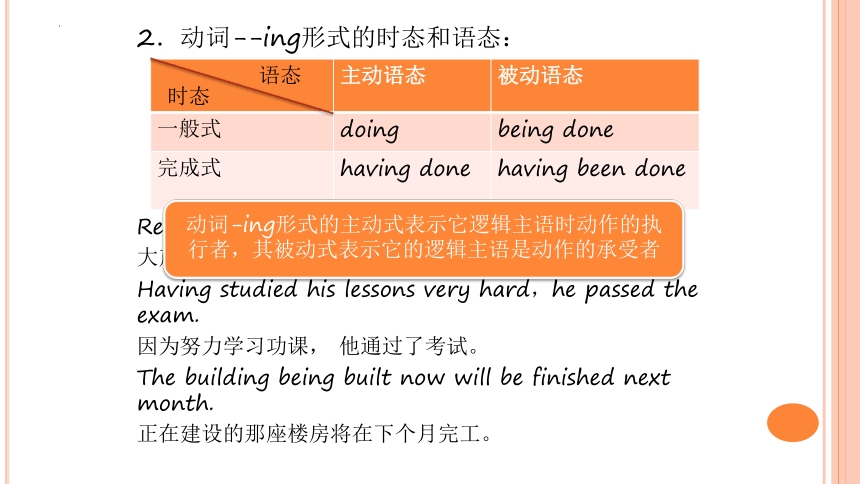

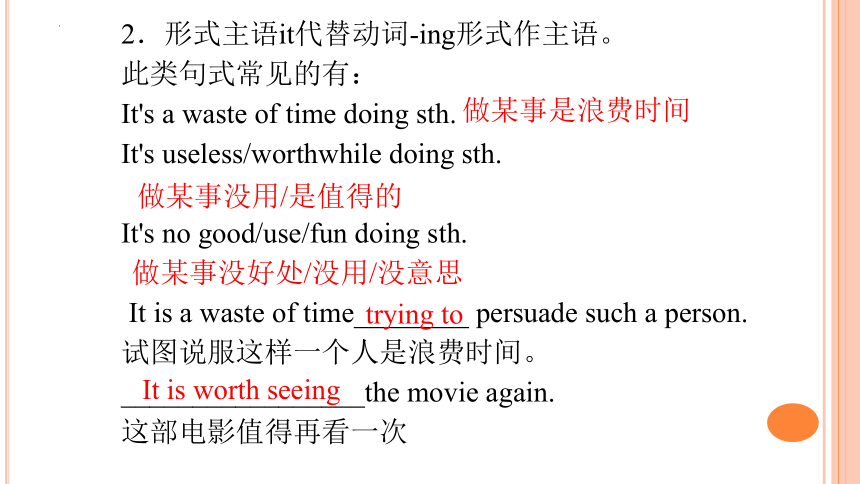
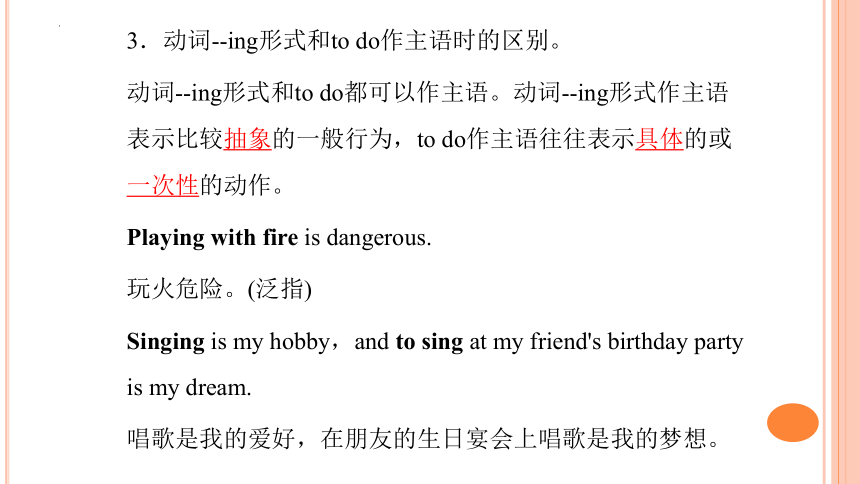
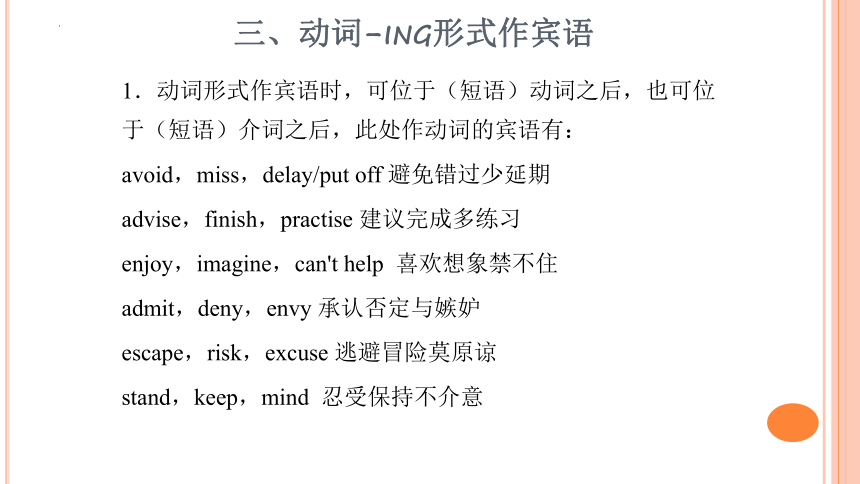
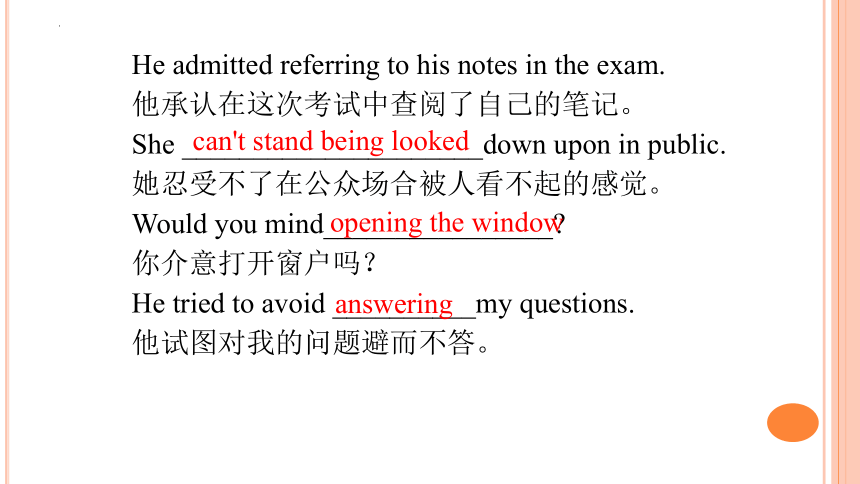
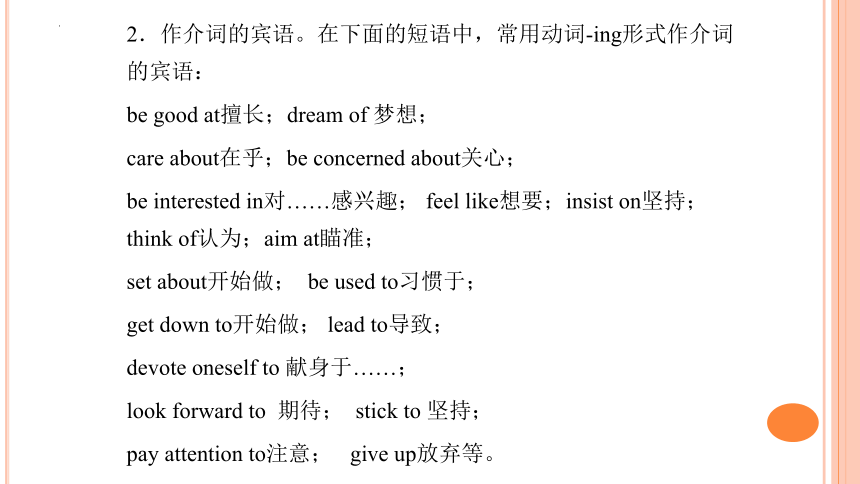
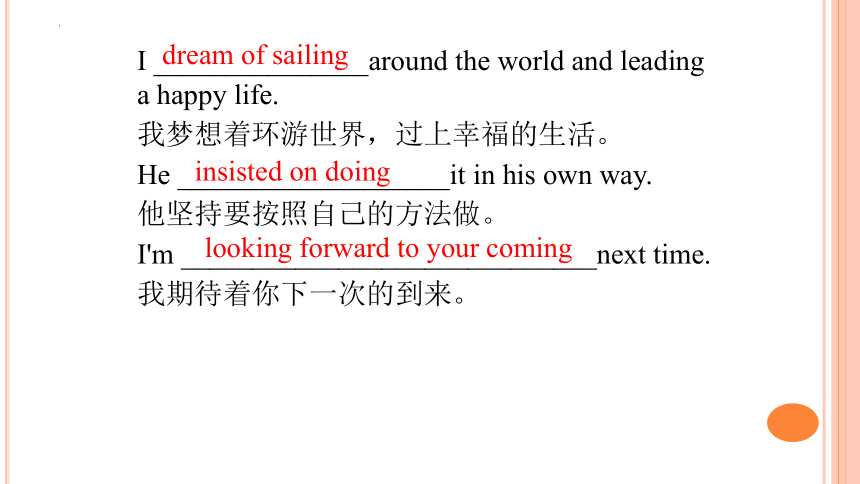
文档简介
(共41张PPT)
unit5 frist aid
Discovering Useful Structures
[观察例句]
1.As you can imagine,getting burnt can lead to very serious injuries.
2.You can protect the burnt area by covering it with a loose clean cloth.
3.The first and most important step in the treatment of burns is giving first aid.
动词-ing 形式
getting为动词- ing形式在句中作主语。
covering为动词 -ing形式在句中作宾语。
giving为动词 -ing形式在句中作表语。
4.It is best to place burns under cool running water,especially within the first ten minutes.
5.If you see someone choking,first call the emergency services.
6.In 1974,an American doctor,Henry Heimlich,created the Heimlich manoeuvre,saving thousands of lives around the world.
running为动词- ing形式在句中作定语
choking为动词- ing形式在句中作宾语补足语
saving为动词- ing形式在句中作状语
一、动词- ing形式的基本情况
1.动词- ing形式是动词的一种非谓语形式。
动词- ing形式在句中的语法作用:在句中作主语、宾语、表语和定语,动词- ing形式在句中作状语、宾语补足语和定语。
2.动词 -ing形式的时态和语态:
Reading aloud is a good way to learn a language.
大声朗读是学习一门语言的一种好方法。
Having studied his lessons very hard,he passed the exam.
因为努力学习功课, 他通过了考试。
The building being built now will be finished next month.
正在建设的那座楼房将在下个月完工。
主动语态 被动语态
一般式 doing being done
完成式 having done having been done
时态
语态
动词-ing形式的主动式表示它逻辑主语时动作的执行者,其被动式表示它的逻辑主语是动作的承受者
二、动词- ing形式作主语
1.动词 -ing形式作主语时,往往表示经常性、习惯性的动作,通常置于句首。动词- ing形式作主语时,谓语动词用单数。
Saying is one thing,and doing is another.
说是一回事,做是另一回事。
______________every day helps to make one keep healthy.
每天散步有助于一个人保持健康。
Climbing mountains ___really difficult for the old.
对于老人来说爬山确实困难。
Having a walk
is
2.形式主语it代替动词 ing形式作主语。
此类句式常见的有:
It's a waste of time doing sth.
It's useless/worthwhile doing sth.
It's no good/use/fun doing sth.
It is a waste of time________ persuade such a person.
试图说服这样一个人是浪费时间。
_________________the movie again.
这部电影值得再看一次
做某事是浪费时间
做某事没用/是值得的
做某事没好处/没用/没意思
trying to
It is worth seeing
3.动词- ing形式和to do作主语时的区别。
动词- ing形式和to do都可以作主语。动词- ing形式作主语表示比较抽象的一般行为,to do作主语往往表示具体的或一次性的动作。
Playing with fire is dangerous.
玩火危险。(泛指)
Singing is my hobby,and to sing at my friend's birthday party is my dream.
唱歌是我的爱好,在朋友的生日宴会上唱歌是我的梦想。
三、动词 ing形式作宾语
1.动词形式作宾语时,可位于(短语)动词之后,也可位于(短语)介词之后,此处作动词的宾语有:
avoid,miss,delay/put off 避免错过少延期
advise,finish,practise 建议完成多练习
enjoy,imagine,can't help 喜欢想象禁不住
admit,deny,envy 承认否定与嫉妒
escape,risk,excuse 逃避冒险莫原谅
stand,keep,mind 忍受保持不介意
He admitted referring to his notes in the exam.
他承认在这次考试中查阅了自己的笔记。
She _____________________down upon in public.
她忍受不了在公众场合被人看不起的感觉。
Would you mind________________
你介意打开窗户吗?
He tried to avoid __________my questions.
他试图对我的问题避而不答。
can't stand being looked
opening the window
answering
2.作介词的宾语。在下面的短语中,常用动词 ing形式作介词的宾语:
be good at擅长;dream of 梦想;
care about在乎;be concerned about关心;
be interested in对……感兴趣; feel like想要;insist on坚持; think of认为;aim at瞄准;
set about开始做; be used to习惯于;
get down to开始做; lead to导致;
devote oneself to 献身于……;
look forward to 期待; stick to 坚持;
pay attention to注意; give up放弃等。
I _______________around the world and leading a happy life.
我梦想着环游世界,过上幸福的生活。
He ___________________it in his own way.
他坚持要按照自己的方法做。
I'm _____________________________next time.
我期待着你下一次的到来。
dream of sailing
insisted on doing
looking forward to your coming
3.在以下结构中,动词 ing形式作介词的宾语,介词常省略。
spend...(in) doing sth.
have difficulty/trouble (in) doing sth.
stop/prevent...(from) doing sth.
waste time (in) doing sth.
be busy (in) doing sth.
have a good/hard time (in) doing sth.
There is no point (in) doing sth.
花费……做某事
做某事有困难/麻烦
阻止……做某事
浪费时间做某事
忙于做某事
高兴做某事/费了很大劲做某事
做某事毫无意义
He ______________________every day,which has made him have little time to play with his child.
他每天总是忙于工作,这使他很少有时间和孩子一起玩。
______________________him such a good chance.
给他提供这样一个好机会没有意义。
is always busy working
There is no point giving
4.动词- ing形式作主语、宾语时的几个特殊情况
(1)动词- ing的复合结构
名词(宾格)/名词-’s所有格形式
代词(宾格)/形容词性物主代词
动词- ing的复合结构的否定形式为:
形容词性物主代词/代词(宾格)/名词/名词的所有格+not doing...。
His/Tom's being late made the teacher very angry.
Would you mind my/me closing the window
Would you mind Mary's/Mary passing Tom the dictionary
+动词 -ing
(2)某些动词及动词短语后面既可以用不定式也可以用动词 ing作宾语。
go on doing sth.继续做同一件事
go on to do sth.接着做另一件事
forget doing sth.忘记做过某事
forget to do sth.忘记要做某事
try doing sth.试着做某事
try to do sth.努力做某事
remember doing sth.记得做过某事
remember to do sth.记住要做某事
regret doing sth.后悔做了某事regret to do sth.很遗憾要做某事
mean to do sth.打算/意欲做某事
mean doing sth.意味着做某事
stop to do sth.停下来去做另一件事
stop doing sth.停止正在做的事情
can't help to do sth.不能帮着去做某事can't help doing sth.禁不住做某事
They stopped to have a look at the fantastic scenery.
他们停下来,去看一看这美妙绝伦的风景。
They stopped working and had a rest.
他们停止工作,休息了一下。
(3)用it作形式宾语,真正的宾语是动词 ing形式。
其结构如下:
think useless
consider no use
主语 find +it+ no good +doing
feel
believe ……
Do you consider it any good trying again
你觉得再试会有用吗?
I found it __________________________about it.
我发现争论这件事没有用。
useless/no use arguing
(4)在动词need,require,want,deserve后,用动词- ing形式表示被动意义,即 need/require/want/deserve doing
=need/require/want/ deserve to be done。
These clothes need washing.
=These clothes need to be washed.
这些衣服需要洗。
The house____________________.
=The house____________________________.
这座房子需要修理。
requires repairing
requires to be repaired
(5)在(be) worth后面只能用动词 ing形式来表示被动意义。
The film is worth seeing a second time.
这部电影值得再看一次。
四、动词 ing形式作表语
1.动词- ing形式(短语)作表语,表示抽象的一般性的行为,用来说明主语的内容,与主语通常是同一概念,表语和主语常可互换位置。
One of his weaknesses is telling lies.
=Telling lies is one of his weaknesses.
他的缺点之一就是说谎。
His hobby is reading books in his spare time.
=Reading books in his spare time is his hobby.
他的爱好是在空闲时间读书。
2.动词 ing形式(短语)作表语,表示主语的某种性质和特征,这类词通常可以看作形容词。
The trip is very exciting,and we have decided to have a similar one.
这次旅行很是激动人心, 我们已决定再进行一次类似的旅行。
[名师点津]
作表语的动词 ing形式,许多是由能够表示人的某种感情或情绪的动词变化而来的。常见的有:moving,interesting,encouraging,exciting,inspiring,boring,surprising,puzzling,amusing,astonishing...这类词有“令人……的”的含义,常修饰物。
五、动词 ing形式作定语
1.动词 -ing形式(短语)作定语,表示名词的属性、作用或用途,作“供……用”讲,常置于被修饰的名词前。
There is a swimming pool in our school.
我们学校有一个游泳池。
Students are not permitted to speak loud in the reading room.
在阅览室里学生们不许大声喧哗。
2.动词 -ing形式(短语)作定语,表示所修饰词的动作或状态,被修饰词与动词- ing形式之间是主动关系,相当于一个定语从句。
The boys gathering at the school gate are my classmates.
=The boys ___________________________________are my classmates.
聚集在校门口的那些男孩是我的同学。
[名师点津]
单个的动词 ing形式作定语时,放在被修饰词前;动词 ing形式短语作定语时,则放在被修饰词后。
who are gathering at the school gate
六、动词 -ing形式作宾语补足语
动词 -ing形式作宾语补足语时,表示正在进行的动作或经常存在的状态。动词 -ing形式常作以下动词的宾语补足语。
1.动词 -ing位于感官动词后:feel,smell,listen to,hear,watch,see,notice,observe 等。
I felt someone patting me on the shoulder.
我感觉有人在拍我的肩膀。
When he passed the swimming pool,he saw someone swimming in it.
当他经过游泳池时, 他看见有人在游泳。
动词 ing与动词不定式在感官动词后的意义
在see,hear,watch等感官动词后,用动词- ing形式作宾语补足语表示动作正在进行;用省略to的不定式作宾语补足语表示动作从开始到结束的全过程。
I heard Mary singing in the next room我听到玛丽正在隔壁唱歌。
I heard Mary sing a song in the next room last night
昨晚我听到玛丽在隔壁唱歌。
(动作正在进行)
(动作全过程)
2.动词 -ing位于使役动词后:have,keep,get,leave,set,make,send等。
She couldn't have him getting away with telling lies.
她不能容忍他撒了谎而不受惩罚。
Please don't keep the little boy staying alone.
不要让这个男孩独自待着。
3.用于with复合结构中。
I couldn't do my homework with the noise going on.
由于噪音不断,我没法做家庭作业。
With so many people looking at her,she feels nervous.
这么多人看着她,她感到很紧张。
七、动词 ing形式作状语
1.作时间状语。
Hearing the news,he couldn't help laughing.
=When he heard the news,he couldn't help laughing.一听到那个消息,他禁不住大笑起来。
2.作原因状语。
Not knowing her address,I had better telephone her to come over.
=As I don't know her address,I had better telephone her to come over.
由于不知道她的地址,我还是打电话让她过来为好。
3.作条件状语。
Working hard,you'll surely succeed.
=If you work hard,you'll surely succeed.
如果努力工作,你就一定会成功。
4.作结果状语。
The child slipped and fell,hitting his head against the door.
=The child slipped and fell,and hit his head against the door.
那个男孩滑了一跤,头撞到了门上。
[名师点津]
动词 ing形式作结果状语,是随着谓语动词的发生而产生的自然结果,而不定式作结果状语时常表示出乎意料的结果,有时前面可以加only。
I hurried to school,only to find it was Sunday.
我匆忙赶到学校,结果发现是星期天。
5.作让步状语。
Having been told many times,he still didn't learn these rules by heart.
=Although he had been told many times,he still didn't learn these rules by heart.
尽管被告知了很多次,他还是没把这些规定记住。
6.作伴随状语。
Morris lay on the grass,staring at the sky for a long time.
=Morris lay on the grass and stared at the sky for a long time.
莫里斯躺在草地上,长时间地望着天空。
The boy sat in front of the farmhouse,cutting the branches.
=The boy sat in front of the farmhouse,and cut the branches.
那个男孩坐在农舍前砍树枝。
7.作方式状语。
He came running back to tell me the news.
他跑回来告诉我这个消息。
[名师点津]
动词 ing形式作状语时,如果表示时间、原因、条件、让步时,那么相当于与之对应的状语从句,但是当表示结果、伴随及方式时,则可转化为并列分句。
8.动词 -ing形式作状语时的注意事项
(1)动词- ing形式的时态
动词- ing形式作状语时,要注意动词 -ing形式的时间性,是用动词- ing形式的一般式(doing),还是用完成式(having done)。
①当动词- ing形式的动作与谓语动词的动作同时发生时,用动词 -ing形式的一般式。
Walking in the street,I met an old friend of mine.
我正在大街上行走时,遇到了一位老朋友。(walking和谓语动词met同时发生)
②当动词- ing形式的动作先发生,而谓语动词的动作后发生时,用动词 -ing形式的完成式。
Having finished the letter,he went to post it.
他写完信后就把它寄了出去。(having finished是先发生的,went是后发生的)
(2)动词 -ing形式的语态
使用动词- ing形式的主动式还是被动式,这主要取决于动词- ing形式和句子主语之间的关系。句子的主语就是动词- ing形式的逻辑主语。
Having been shown around the factory,they were very happy.(动词 ing形式的被动式)
被领着参观了工厂后,他们很高兴。
Having finished his homework,he went to bed.(动词 -ing形式的主动式)
完成了作业后,他就上床睡觉了。
(3)动词 ing形式的否定式:not+v. ing;not having+v. ed
Not knowing this,he didn't come.
他不知道这件事,所以没来。
Not having made full preparations,we put off the sports meeting.
因为没有做好充分的准备,我们把运动会延期了。
(4)动词 ing形式作评注性状语
有些动词 ing形式在句中没有逻辑主语,它们往往作为句子的评注性状语来修饰整个句子,表明说话者的态度、观点等。例如:generally speaking“一般来说”, judging by/from...“从……判断”,taking everything into consideration“从全局考虑”。
Judging from his behaviour,he must be mad.
从他的行为来判断,他一定是疯了。
unit5 frist aid
Discovering Useful Structures
[观察例句]
1.As you can imagine,getting burnt can lead to very serious injuries.
2.You can protect the burnt area by covering it with a loose clean cloth.
3.The first and most important step in the treatment of burns is giving first aid.
动词-ing 形式
getting为动词- ing形式在句中作主语。
covering为动词 -ing形式在句中作宾语。
giving为动词 -ing形式在句中作表语。
4.It is best to place burns under cool running water,especially within the first ten minutes.
5.If you see someone choking,first call the emergency services.
6.In 1974,an American doctor,Henry Heimlich,created the Heimlich manoeuvre,saving thousands of lives around the world.
running为动词- ing形式在句中作定语
choking为动词- ing形式在句中作宾语补足语
saving为动词- ing形式在句中作状语
一、动词- ing形式的基本情况
1.动词- ing形式是动词的一种非谓语形式。
动词- ing形式在句中的语法作用:在句中作主语、宾语、表语和定语,动词- ing形式在句中作状语、宾语补足语和定语。
2.动词 -ing形式的时态和语态:
Reading aloud is a good way to learn a language.
大声朗读是学习一门语言的一种好方法。
Having studied his lessons very hard,he passed the exam.
因为努力学习功课, 他通过了考试。
The building being built now will be finished next month.
正在建设的那座楼房将在下个月完工。
主动语态 被动语态
一般式 doing being done
完成式 having done having been done
时态
语态
动词-ing形式的主动式表示它逻辑主语时动作的执行者,其被动式表示它的逻辑主语是动作的承受者
二、动词- ing形式作主语
1.动词 -ing形式作主语时,往往表示经常性、习惯性的动作,通常置于句首。动词- ing形式作主语时,谓语动词用单数。
Saying is one thing,and doing is another.
说是一回事,做是另一回事。
______________every day helps to make one keep healthy.
每天散步有助于一个人保持健康。
Climbing mountains ___really difficult for the old.
对于老人来说爬山确实困难。
Having a walk
is
2.形式主语it代替动词 ing形式作主语。
此类句式常见的有:
It's a waste of time doing sth.
It's useless/worthwhile doing sth.
It's no good/use/fun doing sth.
It is a waste of time________ persuade such a person.
试图说服这样一个人是浪费时间。
_________________the movie again.
这部电影值得再看一次
做某事是浪费时间
做某事没用/是值得的
做某事没好处/没用/没意思
trying to
It is worth seeing
3.动词- ing形式和to do作主语时的区别。
动词- ing形式和to do都可以作主语。动词- ing形式作主语表示比较抽象的一般行为,to do作主语往往表示具体的或一次性的动作。
Playing with fire is dangerous.
玩火危险。(泛指)
Singing is my hobby,and to sing at my friend's birthday party is my dream.
唱歌是我的爱好,在朋友的生日宴会上唱歌是我的梦想。
三、动词 ing形式作宾语
1.动词形式作宾语时,可位于(短语)动词之后,也可位于(短语)介词之后,此处作动词的宾语有:
avoid,miss,delay/put off 避免错过少延期
advise,finish,practise 建议完成多练习
enjoy,imagine,can't help 喜欢想象禁不住
admit,deny,envy 承认否定与嫉妒
escape,risk,excuse 逃避冒险莫原谅
stand,keep,mind 忍受保持不介意
He admitted referring to his notes in the exam.
他承认在这次考试中查阅了自己的笔记。
She _____________________down upon in public.
她忍受不了在公众场合被人看不起的感觉。
Would you mind________________
你介意打开窗户吗?
He tried to avoid __________my questions.
他试图对我的问题避而不答。
can't stand being looked
opening the window
answering
2.作介词的宾语。在下面的短语中,常用动词 ing形式作介词的宾语:
be good at擅长;dream of 梦想;
care about在乎;be concerned about关心;
be interested in对……感兴趣; feel like想要;insist on坚持; think of认为;aim at瞄准;
set about开始做; be used to习惯于;
get down to开始做; lead to导致;
devote oneself to 献身于……;
look forward to 期待; stick to 坚持;
pay attention to注意; give up放弃等。
I _______________around the world and leading a happy life.
我梦想着环游世界,过上幸福的生活。
He ___________________it in his own way.
他坚持要按照自己的方法做。
I'm _____________________________next time.
我期待着你下一次的到来。
dream of sailing
insisted on doing
looking forward to your coming
3.在以下结构中,动词 ing形式作介词的宾语,介词常省略。
spend...(in) doing sth.
have difficulty/trouble (in) doing sth.
stop/prevent...(from) doing sth.
waste time (in) doing sth.
be busy (in) doing sth.
have a good/hard time (in) doing sth.
There is no point (in) doing sth.
花费……做某事
做某事有困难/麻烦
阻止……做某事
浪费时间做某事
忙于做某事
高兴做某事/费了很大劲做某事
做某事毫无意义
He ______________________every day,which has made him have little time to play with his child.
他每天总是忙于工作,这使他很少有时间和孩子一起玩。
______________________him such a good chance.
给他提供这样一个好机会没有意义。
is always busy working
There is no point giving
4.动词- ing形式作主语、宾语时的几个特殊情况
(1)动词- ing的复合结构
名词(宾格)/名词-’s所有格形式
代词(宾格)/形容词性物主代词
动词- ing的复合结构的否定形式为:
形容词性物主代词/代词(宾格)/名词/名词的所有格+not doing...。
His/Tom's being late made the teacher very angry.
Would you mind my/me closing the window
Would you mind Mary's/Mary passing Tom the dictionary
+动词 -ing
(2)某些动词及动词短语后面既可以用不定式也可以用动词 ing作宾语。
go on doing sth.继续做同一件事
go on to do sth.接着做另一件事
forget doing sth.忘记做过某事
forget to do sth.忘记要做某事
try doing sth.试着做某事
try to do sth.努力做某事
remember doing sth.记得做过某事
remember to do sth.记住要做某事
regret doing sth.后悔做了某事regret to do sth.很遗憾要做某事
mean to do sth.打算/意欲做某事
mean doing sth.意味着做某事
stop to do sth.停下来去做另一件事
stop doing sth.停止正在做的事情
can't help to do sth.不能帮着去做某事can't help doing sth.禁不住做某事
They stopped to have a look at the fantastic scenery.
他们停下来,去看一看这美妙绝伦的风景。
They stopped working and had a rest.
他们停止工作,休息了一下。
(3)用it作形式宾语,真正的宾语是动词 ing形式。
其结构如下:
think useless
consider no use
主语 find +it+ no good +doing
feel
believe ……
Do you consider it any good trying again
你觉得再试会有用吗?
I found it __________________________about it.
我发现争论这件事没有用。
useless/no use arguing
(4)在动词need,require,want,deserve后,用动词- ing形式表示被动意义,即 need/require/want/deserve doing
=need/require/want/ deserve to be done。
These clothes need washing.
=These clothes need to be washed.
这些衣服需要洗。
The house____________________.
=The house____________________________.
这座房子需要修理。
requires repairing
requires to be repaired
(5)在(be) worth后面只能用动词 ing形式来表示被动意义。
The film is worth seeing a second time.
这部电影值得再看一次。
四、动词 ing形式作表语
1.动词- ing形式(短语)作表语,表示抽象的一般性的行为,用来说明主语的内容,与主语通常是同一概念,表语和主语常可互换位置。
One of his weaknesses is telling lies.
=Telling lies is one of his weaknesses.
他的缺点之一就是说谎。
His hobby is reading books in his spare time.
=Reading books in his spare time is his hobby.
他的爱好是在空闲时间读书。
2.动词 ing形式(短语)作表语,表示主语的某种性质和特征,这类词通常可以看作形容词。
The trip is very exciting,and we have decided to have a similar one.
这次旅行很是激动人心, 我们已决定再进行一次类似的旅行。
[名师点津]
作表语的动词 ing形式,许多是由能够表示人的某种感情或情绪的动词变化而来的。常见的有:moving,interesting,encouraging,exciting,inspiring,boring,surprising,puzzling,amusing,astonishing...这类词有“令人……的”的含义,常修饰物。
五、动词 ing形式作定语
1.动词 -ing形式(短语)作定语,表示名词的属性、作用或用途,作“供……用”讲,常置于被修饰的名词前。
There is a swimming pool in our school.
我们学校有一个游泳池。
Students are not permitted to speak loud in the reading room.
在阅览室里学生们不许大声喧哗。
2.动词 -ing形式(短语)作定语,表示所修饰词的动作或状态,被修饰词与动词- ing形式之间是主动关系,相当于一个定语从句。
The boys gathering at the school gate are my classmates.
=The boys ___________________________________are my classmates.
聚集在校门口的那些男孩是我的同学。
[名师点津]
单个的动词 ing形式作定语时,放在被修饰词前;动词 ing形式短语作定语时,则放在被修饰词后。
who are gathering at the school gate
六、动词 -ing形式作宾语补足语
动词 -ing形式作宾语补足语时,表示正在进行的动作或经常存在的状态。动词 -ing形式常作以下动词的宾语补足语。
1.动词 -ing位于感官动词后:feel,smell,listen to,hear,watch,see,notice,observe 等。
I felt someone patting me on the shoulder.
我感觉有人在拍我的肩膀。
When he passed the swimming pool,he saw someone swimming in it.
当他经过游泳池时, 他看见有人在游泳。
动词 ing与动词不定式在感官动词后的意义
在see,hear,watch等感官动词后,用动词- ing形式作宾语补足语表示动作正在进行;用省略to的不定式作宾语补足语表示动作从开始到结束的全过程。
I heard Mary singing in the next room我听到玛丽正在隔壁唱歌。
I heard Mary sing a song in the next room last night
昨晚我听到玛丽在隔壁唱歌。
(动作正在进行)
(动作全过程)
2.动词 -ing位于使役动词后:have,keep,get,leave,set,make,send等。
She couldn't have him getting away with telling lies.
她不能容忍他撒了谎而不受惩罚。
Please don't keep the little boy staying alone.
不要让这个男孩独自待着。
3.用于with复合结构中。
I couldn't do my homework with the noise going on.
由于噪音不断,我没法做家庭作业。
With so many people looking at her,she feels nervous.
这么多人看着她,她感到很紧张。
七、动词 ing形式作状语
1.作时间状语。
Hearing the news,he couldn't help laughing.
=When he heard the news,he couldn't help laughing.一听到那个消息,他禁不住大笑起来。
2.作原因状语。
Not knowing her address,I had better telephone her to come over.
=As I don't know her address,I had better telephone her to come over.
由于不知道她的地址,我还是打电话让她过来为好。
3.作条件状语。
Working hard,you'll surely succeed.
=If you work hard,you'll surely succeed.
如果努力工作,你就一定会成功。
4.作结果状语。
The child slipped and fell,hitting his head against the door.
=The child slipped and fell,and hit his head against the door.
那个男孩滑了一跤,头撞到了门上。
[名师点津]
动词 ing形式作结果状语,是随着谓语动词的发生而产生的自然结果,而不定式作结果状语时常表示出乎意料的结果,有时前面可以加only。
I hurried to school,only to find it was Sunday.
我匆忙赶到学校,结果发现是星期天。
5.作让步状语。
Having been told many times,he still didn't learn these rules by heart.
=Although he had been told many times,he still didn't learn these rules by heart.
尽管被告知了很多次,他还是没把这些规定记住。
6.作伴随状语。
Morris lay on the grass,staring at the sky for a long time.
=Morris lay on the grass and stared at the sky for a long time.
莫里斯躺在草地上,长时间地望着天空。
The boy sat in front of the farmhouse,cutting the branches.
=The boy sat in front of the farmhouse,and cut the branches.
那个男孩坐在农舍前砍树枝。
7.作方式状语。
He came running back to tell me the news.
他跑回来告诉我这个消息。
[名师点津]
动词 ing形式作状语时,如果表示时间、原因、条件、让步时,那么相当于与之对应的状语从句,但是当表示结果、伴随及方式时,则可转化为并列分句。
8.动词 -ing形式作状语时的注意事项
(1)动词- ing形式的时态
动词- ing形式作状语时,要注意动词 -ing形式的时间性,是用动词- ing形式的一般式(doing),还是用完成式(having done)。
①当动词- ing形式的动作与谓语动词的动作同时发生时,用动词 -ing形式的一般式。
Walking in the street,I met an old friend of mine.
我正在大街上行走时,遇到了一位老朋友。(walking和谓语动词met同时发生)
②当动词- ing形式的动作先发生,而谓语动词的动作后发生时,用动词 -ing形式的完成式。
Having finished the letter,he went to post it.
他写完信后就把它寄了出去。(having finished是先发生的,went是后发生的)
(2)动词 -ing形式的语态
使用动词- ing形式的主动式还是被动式,这主要取决于动词- ing形式和句子主语之间的关系。句子的主语就是动词- ing形式的逻辑主语。
Having been shown around the factory,they were very happy.(动词 ing形式的被动式)
被领着参观了工厂后,他们很高兴。
Having finished his homework,he went to bed.(动词 -ing形式的主动式)
完成了作业后,他就上床睡觉了。
(3)动词 ing形式的否定式:not+v. ing;not having+v. ed
Not knowing this,he didn't come.
他不知道这件事,所以没来。
Not having made full preparations,we put off the sports meeting.
因为没有做好充分的准备,我们把运动会延期了。
(4)动词 ing形式作评注性状语
有些动词 ing形式在句中没有逻辑主语,它们往往作为句子的评注性状语来修饰整个句子,表明说话者的态度、观点等。例如:generally speaking“一般来说”, judging by/from...“从……判断”,taking everything into consideration“从全局考虑”。
Judging from his behaviour,he must be mad.
从他的行为来判断,他一定是疯了。
